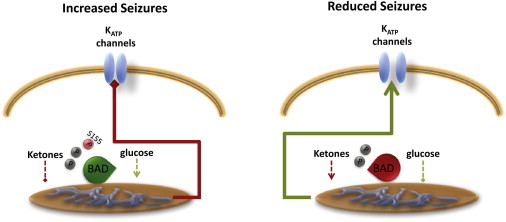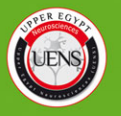- Details
- Biju Hameed
- News
- Hits: 631
An important work published in the May 24 issue of Neuron by, researchers from Dana-Farber Cancer Institute and Harvard Medical School helps toward the understanding of the molecular mechanisms of mitochondrial and metabolic control of seizures and helps to uncover how the ketogenic diet works in epilepsy.
The efficacy of the ketogenic diet in children with epilepsy has pointed to a role for metabolism as a component of the pathogenesis of seizures. However the molecular mechanisms behind the dependence of neuronal activity on metabolic substrates has not been fully understood2. In parallel to its role in apoptosis, the Bcl-2-associated death promoter (BAD) protein , a pro-apoptotic member of the Bcl-2 gene family, has been shown to have an important role in glucose metabolism and utilization.
In this respect the phosphorylation of BAD does not only prevent initiation of cell death, but it is also required for efficient mitochondrial utilization of glucose in liver. Dephosphorylated BAD forms a heterodimer with Bcl-2 and Bcl-xL, inactivating them and thus allowing Bax/Bak-triggered apoptosis.
Giménez-Cassina et al. (2012) investigating the potential role of BAD in seizures, found the existence of a phosphodependent regulatory switch in BAD that reduces neuronal excitability upon kainic acid-induced seizures. Similar to what occurs in the liver they showed that cortical neurons and astrocytes from Bad−/− mice display lower glucose utilization for mitochondrial respiration.
This showed an interesting connection between BAD deficient mice or mice with nonphosphorylable BAD and ketogenic diet which reduces seizures in terms of glucose utilization by mitochondria.
The authors therefore investigated whether BAD might also influence seizure sensitivity in vivo. They found that BAD deficient as well as BadS155A(mice bearing a phosphodeficient knockin allele of Bad at serine 155) mice were significantly protected from the proconvulsant drug kainic acid. Moreover, seizure resistance was specific for BAD and independent from its proapoptotic function, pointing therefore to its role in metabolism.
 BAD Phosphorylation Controls Mitochondrial Fuel Utilization to Switch Neuronal ExcitabilityThe proapoptotic BH3-only protein BAD can be viewed as a relay: its phosphorylation on Ser 155 switches the preferred source of reducing equivalents for mitochondria from glucose to ketones. Plasma membrane KATP channels are closed in neurons with “glycolytic” mitochondria, as opposed to the ones where mitochondria use ketone bodies and that are less susceptible to seizures. (source: Neuron Volume 74, Issue 4, 24 May 2012, Pages 600–602)The Ketogenic diet has been shown to increases the activity of KATP channels. KATP channels are activated following decreased intracellular ATP, in a negative feedback loop that is believed to help neurons to overcome excitotoxicity during seizure. Giménez-Cassina et al. also found that the dentate granule neurons (DGNs) of hippocampal slices from BAD deficient (Bad−/− ) mice showed increased single KATP channels, while ablation of KATP channels expression in BAD deficient (Bad−/− ) mice diminished their resistance to seizures .
BAD Phosphorylation Controls Mitochondrial Fuel Utilization to Switch Neuronal ExcitabilityThe proapoptotic BH3-only protein BAD can be viewed as a relay: its phosphorylation on Ser 155 switches the preferred source of reducing equivalents for mitochondria from glucose to ketones. Plasma membrane KATP channels are closed in neurons with “glycolytic” mitochondria, as opposed to the ones where mitochondria use ketone bodies and that are less susceptible to seizures. (source: Neuron Volume 74, Issue 4, 24 May 2012, Pages 600–602)The Ketogenic diet has been shown to increases the activity of KATP channels. KATP channels are activated following decreased intracellular ATP, in a negative feedback loop that is believed to help neurons to overcome excitotoxicity during seizure. Giménez-Cassina et al. also found that the dentate granule neurons (DGNs) of hippocampal slices from BAD deficient (Bad−/− ) mice showed increased single KATP channels, while ablation of KATP channels expression in BAD deficient (Bad−/− ) mice diminished their resistance to seizures .
The study thus linked BAD phosphorylation and KATP channels activity to the attenuation of seizures, a hitherto unknown signalling pathway The study, funded by Harvard Catalyst, Citizens United for Research in Epilepsy, and the NIH has contributed significantly to the understanding of the molecular mechanisms of mitochondrial and metabolic control of seizures with potential implications for future therapeutic strategies.
Citations
1. Elena Ziviani, Luca Scorrano. Neuron, Volume 74, Issue 4, 24 May 2012, Pages 600-602
2. Giménez-Cassina et al. Neuron, 74 (2012), pp. 719–730
Read More
- Details
- ICNA
- News
- Hits: 632
 The next few years will be exciting for the ICNA and its members. In the current report we move away from activities in Europe (for now) and cover the ICNA meeting in Uganda on “Children with Epilepsy”, the build-up to the imminent Brisbane ICNC and address the next ICNC in 2014 which will be in Brazil.
The next few years will be exciting for the ICNA and its members. In the current report we move away from activities in Europe (for now) and cover the ICNA meeting in Uganda on “Children with Epilepsy”, the build-up to the imminent Brisbane ICNC and address the next ICNC in 2014 which will be in Brazil.
This Newsletter is timed to come out just before the 12th ICNC in Brisbane. In future, editions will continue to be mid-year and towards the end of the year, or just prior to major meetings. The ICNA AGM agenda is available in this edition included, it itemises one of the important proposals for the membership to vote on, namely that of whether the association should move to free membership! The board discussed this and voted in favour of the proposal but the final decision will lie with the membership - read on if you want to know more.
A number of bursaries and awards will be received at the 12th ICNC in Brisbane - these are summarised in this issue.
Crossing the globe further the dynamic Pratibha Singhi continues her work in her country and has provided a report on the meeting on “Childhood Epilepsy in Office Practice” in India which she was part of.
Enjoy this issue - please remember to send me suggestions of topics you would like included and any interesting photos. Also any brave vignettes you would share with the readers.
Jo Wilmshurst
Editor
Read More
- Details
- ICNA
- News
- Hits: 695
In a study published in the Annals of Neurology, researchers at Georgetown University Medical Center (GUMC) report that the anti-epilepsy drug phenobarbital given to rat pups about a week old changed the way the animals' brains were wired, causing cognitive abnormalities later in life. The results provide the first evidence that exposure to antiepileptic drugs during a sensitive postnatal period impairs physiological maturation of synapses in neurons that survive the initial drug insult.
Using patch-clamp recordings to examine functional synaptic maturation in striatal medium spiny neurons from neonatal rats exposed to antiepileptic drugs with proapoptotic action (phenobarbital, phenytoin, lamotrigine) and without proapoptotic action (levetiracetam). Phenobarbital-exposed rats were also assessed for reversal learning at weaning.
Synaptic maturation was absent in rats exposed at P7 to a single dose of phenobarbital, phenytoin, or lamotrigine, but not levetiracetam. Interestingly melatonin pretreatment which prevents drug induced neurodevelopmental apoptosis, prevented this disruption in maturation.
The study raises new questions about using phenobarbitone as the first-line drug to treat epilepsy in neonates.
Citation: Forcelli, P. A., Janssen, M. J., Vicini, S. and Gale, K. (2012), Neonatal exposure to antiepileptic drugs disrupts striatal synaptic development. Ann Neurol.. doi: 10.1002/ana.23600 [abstract]
Read More
- Details
- ICNA
- News
- Hits: 864
 1st Upper Egypt Neuroscience September 12-13, 2012
1st Upper Egypt Neuroscience September 12-13, 2012
Pyramisa Blue Lagoon, Hurghada
Only 116 days to Go
Reasons to Book Now
With more than 40 key persons, over 30 oral presentations, teaching sessions and special interest groups happening during the 2 days of the conference, you don't want to miss out on this congress of 1st Upper Egypt Neuroscience, in Collaboration with Upper Egypt Universities.
Very spectacular and interesting scientific sessions with our Neurology, Neurosurgery, Psychiatry & Pediatric Neurology colleagues from the all Egypt with a warm social activities, how can Neuropsychiatrists meet together ?. What's new in Neuroscience ?
To register for 1st Upper Egypt Neuroscience, 2012 please visit the following link: http://www.cme-group.net
Important dates : Early registration deadline : 15/07/2012
Abstract submission deadline : 15/07/2012
Accommodation Deadline : 01/08/2012 Late registration deadline : 15/08/2012
Onsite registration : after 15/08/2012
Prof. Amal Tawfik Prof. of Neurology, Menia University
President of the Conference
Ahmed Raouf, MD.
General Secretary of the Conference & Society
Prof. Of Pediatrics & Pediatric Neurology and Neuro- Rehabilitation, ARRC
Consultant of Pediatric Neurology, IPGCS EB
Member of International Child Neurology Association ( ICNA )
Vice - President of African Pediatric Neurology Association ( APNA )
+2 0100 142 6669
Read More
- Details
- ICNA
- News
- Hits: 854
 1st Upper Egypt Neuroscience September 12-13, 2012
1st Upper Egypt Neuroscience September 12-13, 2012
Pyramisa Blue Lagoon, Hurghada
Only 116 days to Go
Reasons to Book Now
With more than 40 key persons, over 30 oral presentations, teaching sessions and special interest groups happening during the 2 days of the conference, you don't want to miss out on this congress of 1st Upper Egypt Neuroscience, in Collaboration with Upper Egypt Universities.
Very spectacular and interesting scientific sessions with our Neurology, Neurosurgery, Psychiatry & Pediatric Neurology colleagues from the all Egypt with a warm social activities, how can Neuropsychiatrists meet together ?. What's new in Neuroscience ?
To register for 1st Upper Egypt Neuroscience, 2012 please visit the following link: http://www.cme-group.net
Important dates : Early registration deadline : 15/07/2012
Abstract submission deadline : 15/07/2012
Accommodation Deadline : 01/08/2012 Late registration deadline : 15/08/2012
Onsite registration : after 15/08/2012
Prof. Amal Tawfik Prof. of Neurology, Menia University
President of the Conference
Ahmed Raouf, MD.
General Secretary of the Conference & Society
Prof. Of Pediatrics & Pediatric Neurology and Neuro- Rehabilitation, ARRC
Consultant of Pediatric Neurology, IPGCS EB
Member of International Child Neurology Association ( ICNA )
Vice - President of African Pediatric Neurology Association ( APNA )
+2 0100 142 6669
Read More